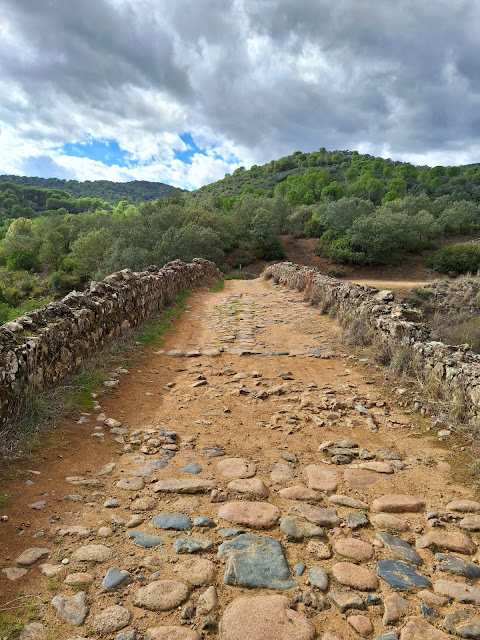In late autumn 2023 we decided to walk one of the more well known walking routes in the Sierra of Cordoba: la ruta de los puentes. This short route runs along the banks of the Guadiato just 30 minutes from Cordoba city. Taking in four bridges along the way, it also offers views of some of the most beautiful parts of the sierra.
We start at Arenales bridge, where we can park the car. The bridge itself is a good vantage point to look for the electric blue flash of Kingfishers. If we follow the path from the bridge, with the river on our right, we come to the ruins of a bridge which was reportedly destroyed during the Civil War to slow the advance of Francist troops. Now not much remains, except for the pilars covered in graffitti and vegetation.
 |
Rio Guadiato
|
Returning to the Aranales Bridge, we head in the opposite direction, this time keeping the river on our left at all times. As we descend to the river we can enjoy the shade provided by the elms, willows and alders. The silence here is only broken by the song of great tits, blue tits, robins and blackcaps.
 |
Blue Tit
|
 |
| Blackcap |
Normally my eyes are scanning the trees and the sky for the movement of birds, but here it paid to pay attention to the ground. After a period of rainfall, mushrooms of numerous types had sprouted.
 |
| Puffball |
After about 30 minutes pine trees become more abundant and in the gaps between the trees we caught sight of Griffon Vultures riding the thermals above. And then a flash of silent movement between the trees. A goshhawk, appearing to have come from nowhere, stopped in front of us with its prey..Its piercing yellow eyes scanning the area before it began to pluck the breast feathers of its victim.
 |
| Goshawk |
 |
Goshawk plucking the feathers of its prey
|
Before long we arrive at the Roman bridge at the mouth of the Guadalnuño River. This remarkably well conserved bridge was built in the 1st Century, and was an important passing point of goods and armies in Arab times, uniting Cordoba with Badajoz.
 |
| Roman bridge over the Guadalnuño River |
From here we can cross the bridge and follow the path for about another 400 metres until we come to Puente de la Tejera. This bridge built in the 9th century and was used until the late 19th century as part of the main road between Córdoba and Villaviciosa. Originally composed of 9 arches, it now lies partially in ruins, with three of the arches having collapsed. However it is still possible to walk across the remaining section of the bridge for views of the river below.
 |
View from the Puente de la Tejera
|
From here the path becomes much narrower and more difficult to follow, so we decided to retrace our steps and head back to Cordoba. This exercusion reminded me of both the beauty of nature and the wealth of history which lie on my doorstep.


























